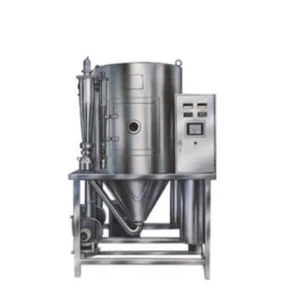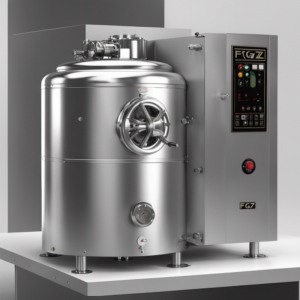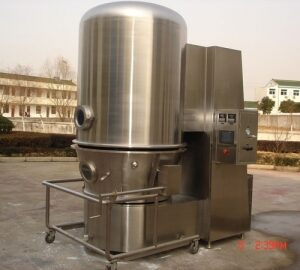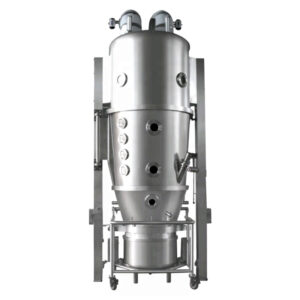Pharmaceutical Dryer
Qualipak Pharmaceutical Dryer is a device designed to provide excellent drying and maintain accurate temperature within an incredibly short timeframe so that pharmaceutical substances are not spoiled. Our reliability in terms of supplying pharmaceutical equipment lies with Qualipak. We have the last word in top-notch technology for your production needs. Honing for perfection through Qualipak.
Introduction of Pharmaceutical Dryer
The drying process is crucial in the pharmaceutical industry to guarantee the stability, efficacy, and quality of medical products. The latter effectively takes moisture out of different pharma entities, thus playing an important role. In addition, this comprehensive guide provides insights into various kinds of pharmaceutical dryers, their work principles, usage areas, roles and functions as well as future trends in this industry. Also, it contains information about servicing the above equipment.
Types of Pharmaceutical Dryers
,1. Fluid Bed Dryers
Working Principle: Materials are fluidized and dried by hot air while they are suspended on a cushion of air. Airstreams with heat applied to them carry air-suspending particles that remove water.
Applications: These are used for drying granules powders or pellets in the production processes for medicines.
Benefits: Uniform drying procedure; gentle material handling; flexibility in operation.
2. Tray Dryers
Working Principle: Material is spread out in thin layers on heated trays for drying purposes. This causes currents of warm air to pass over them through these trays to dry them out.
Applications: It can be applied for drying bulk quantities of solid materials like tablets, capsules and powders.
Benefits: This is economical and hence useful in large-scale producing manufacturers; easy control.
3. Vacuum Dryers
Working Principle: Working under low pressure conditions allows vacuum dryers to reduce liquids boiling points thereby facilitating faster evaporation apart from even delicate drying at lower temperatures.
Applications: They are used for drying heat-sensitive substances such as pharmaceuticals vitamins enzymes among others.
Benefits: Minimizes degradation of heat-sensitive compounds; maintains product quality; enables solvent recovery.
4. Spray Dryers
Working Principle: Liquid feed is atomized into fine droplets which are subsequently dried quickly using hot air in a chamber as shown below (Figure 4). The collected particles have already been dried after removal from the bottom chamber.
Applications: Widespread use occurs when there is a need to dry liquids i.e. suspensions, emulsions and solutions into powders.
Benefits: Produces free-flowing powders with controlled particle size; improves product solubility; enables sensitive ingredients encapsulation.
5. Rotary Dryers
Working Principle: These are made up of rotating drums through which hot air passes thus drying their content. The rotation also ensures that drying is even.
Applications: Such dryers can be used for diverse materials including pharmaceuticals, chemicals and foods like granules, powders and pastes.
Benefits: The ability to treat large quantities at once; save energy; it operates as a versatile device because of the numerous different components that it has for various kinds of materials’ drying.
Working Processes Of Pharmaceutical Dryers
The working processes of different types of pharmaceutical dryers differ. However, the main idea remains the same i.e., heat and air flow remove moisture from pharmaceutical products. Here is a brief overview of the working processes:
Material Loading: Depending on the design of the equipment such as manual or automatic, the pharma product to be dried is loaded into the dryer.
Heating: The drying chamber/drum is heated raising its temperature to facilitate the evaporation of moisture from the product within it.
Airflow: In fluid bed dryers, tray dryers and spray dryers air circulates across the region where drugs are being produced to fasten the drying process while reduced pressure assists in vaporization in vacuum driers.
Moisture Removal: Gradually evaporated by heat & airflow acting upon them while the item is still inside the chamber or system leads to moisture removal
Product Discharge: After becoming dried products from drug industries are removed for further processing or packing them again when required.
Applications Of Pharmaceutical Dryers
Pharmaceutical dryers have extensive applications in different stages of pharmaceutical manufacturing and processing. Some of them include:
Drying of APIs
Granulation drying
Aiding excipients and intermediates to become dry
Tablet coating drying
Powder drying for capsule filling
Drying herbs and plant materials
Drying parenteral formulations (injectables)
Lyophilization (freeze-drying) of Pharmaceuticals.
The range of these uses outlines the versatility and importance of these dryers in maintaining the quality, sterility, efficacy as well as stability of pharmaceutical products.
Functions and Benefits of Pharmaceutical Dryers
Functions
Moisture Removal: The main purpose or function for which the dryers are used is the reduction of moisture contents to certain levels considered suitable for medicinal products.
Particle Size Reduction: Spray dryers for example can also produce powders with controlled particle sizes through atomization.
Product Preservation: Dryers help preserve the stability, shelf-life, and quality; by removing moisture from them.
Process Efficiency: They are used in improving process efficiency such as reducing drying times, optimizing energy consumption and improving product uniformity among others.
Benefits
Improved Product Quality: Proper drying ensures that pharmaceutical products are uniformly dried thus having high quality. This reduces the chances that microbial contamination will take place or degradation will occur.
Increased Production Efficiency: Faster drying times made possible by pharmaceutical dryers allow more production throughput leading to higher production efficiencies and reduced costs per unit produced by the company.
Versatility: Different types of driers cater to a wide range of pharmaceuticals’ drying requirements allowing flexibility in terms of processing various materials and formulations in this sector.
Regulatory Compliance: Use reliable and validated driers to ensure that regulatory requirements set out for good manufacturing practices (GMP) other than those associated with stringent pharmaceutical manufacturing are met by manufacturers.
Cost Savings: Energy consumption is significantly lowered when companies have efficient drying processes resulting in low product loss as well as minimum resource utilization.
Future Trends in Pharmaceutical Drying Technology
Technological advancements, regulatory pressures, and the need to improve product quality and efficiency are driving the continuous evolution of the pharmaceutical industry. Several trends shaping the future of pharmaceutical drying are discussed below:
Advanced Process Control: Integration of automation, data analytics and artificial intelligence (AI) into real-time monitoring and control of drying processes that deliver precision drying and quality assurance.
Continuous Manufacturing: Continuous fluid bed drying, and spray drying, among others enable improved process efficiency, reduced cycle times and more consistent products.
Green Drying Technologies: The development of environmentally friendly drying approaches that employ renewable energy sources like solar power; solvent-free processes; and green materials such as biopolymers which utilize subjects with less environmental impact for a sustainable world.
Maintenance and Training of Pharmaceutical Dryers
The efficient operation and safety of pharmaceutical dryers depend on proper maintenance. Regular upkeep helps prevent equipment failures, maintain quality control, and ensure adherence to regulatory norms. Some essential maintenance practices for pharmaceutical dryers are;
Regular Maintaining: Routinely clean the interior and exterior surfaces of the dryer to eliminate any product remnants, dust or pollutants. Use authorized cleaning agents and adhere to standard operating procedures (SOPs) to avoid cross-contamination.
Part Inspections: Regularly inspect critical parts such as filters, heaters, fans and seals for wear, corrosion or damage. Replace or repair parts when necessary to prevent equipment breakdown.
Oil Up: Lubricate moving components as outlined by the manufacturer’s specifications so that they reduce friction and run smoothly. Employ pharmaceutical-compatible oils so that no contamination occurs.
Adjustment: Regularly calibrate temperature and humidity sensors to accurately monitor drying conditions. Follow calibration procedures given by the equipment manufacturers or regulatory guidelines.
Safety Audit: Validate the working of safety features like emergency stops, pressure relief valves and interlocks. Test safety systems routinely for compliance with safety standards in addition to keeping operators out of danger.
Preventive Maintenance Plan: Develop a preventive maintenance plan based on equipment usage, manufacturer recommendations, and regulatory requirements. Document maintenance activities completely to have detailed records for audit trails and compliance purposes.
Training of Maintenance Staff Members: Offer all-around training to maintenance staff on how different pharmaceutical dryers work among other related issues. They must also learn about why strict adherence should be made to SOPs; observance of safety protocols as well as regulatory guidelines has been emphasized.
List of Spare Parts Required: Always keep some spare essential parts that may help minimize production downtime during machine failure situations. The reliability of a device is assessed through lead time and, criticality among others in obtaining spares
Emergency Preparedness Strategy: an emergency response plan that outlines how equipment failures can be handled in case there is a power interruption or any other unforeseen circumstances need to be created. Train employees on emergency protocols while ensuring that suppliers’ contact details are always available on speed dials at all times.
Documentation System For Record Keeping And Reporting: Maintenance logs, inspection reports and equipment history form detailed records of maintenance activities. Immediately report any deviations abnormalities, or incidents from standard operating conditions to management as well as QA personnel.
Pharmaceutical manufacturers can ensure that their dryer machines perform reliably, have long life spans and are compliant by following these maintenance practices diligently.
Instructional Materials for Pharmaceutical Dryer Operators
For pharmaceutical dryers to be operated safely and efficiently, proper operator training is required. Operator training promotes adherence to SOPs, enhances equipment proficiency, and improves product quality. Here are some key areas to consider when training operators of pharmaceutical dryers.
Equipment Introduction: Give in-depth training on the specific type of dryer used in a particular pharmaceutical facility. Educate operators about the machine layout, operating controls, safety features and basic principles behind its operation.
Safety Induction: Organize a safety induction programmed for them during which they will learn about hazards such as electrocution, high temperatures or exposure to chemicals/dust while using the dryer. They should know what personal protective equipment is used in their daily routine work.
Operating Methods: Instruct workers on how to load/unload the dryer as well as operate or clean it according to required SOPs. They must understand control settings; and sequences of actions including emergency procedures.
Process Control: Explain how operators can monitor critical process parameters like temperature, airflow rate or humidity and drying time. Help them identify signs of process deviations requiring immediate action.
Quality Assurance: Make sure that the operators understand the value of Good Manufacturing Practices (GMP) and the need to comply with them. Also, let them know how to sample and document as per protocols established for quality checking.
Troubleshooting Skills: Instruct operators on basic troubleshooting methods that will enable the detection and solution of common machine breakdowns or malfunctions. Additionally, these individuals should have skills in efficient mechanical, electrical or system problem-solving.
Maintenance Awareness: Ensure that operators get to understand why they should give utmost importance to equipment maintenance. Let them know how maintenance requirements are identified as well as when maintenance personnel are supposed to be informed about equipment defects and other abnormalities.
Regulatory Compliance: Operators must understand pharmaceutical manufacturing regulations related to documentation, record keeping and reporting requirements. They should also be trained on drying processes that adhere to regulatory requirements
Simulation and Hands-on Practice: Permitting hands-on training sessions along with apparatus simulations is an extra way of enhancing theoretical education as well as practical competence. The trainees need supervision while engaging in activities such as loading/unloading or repairing a drier.
Continuous Training and Refresher Courses: Carry out regular training sessions and refresher courses to update operators on new equipment technologies, process improvements, and regulatory changes. Therefore learning can continue throughout their working life span since skill development enhances organizational efficiency.
Frequently asked questions
What is a pharmaceutical dryer? Why is it important in the pharmaceutical industry?
A specialized piece of equipment used for removing water from pharmaceutical products so they are stable, effective and of good quality is called a pharmaceutical dryer. It’s necessary for product standardization within pharmaceutical production while also ensuring all required standards are met.
What types of different pharma dryers are commonly found?
In general, there are many types of dryers used in the processing industry including fluid bed dryers; tray dryers; vacuum dryers; spray dryers; and rotary dryers among others. Each of these dryers has its own operating principles, applications and suitability for various pharmaceutical drying needs.
How does a pharma dryer work?
The working principle depends on the type of a particular dryer. It generally consists of applying heat and air to the products to induce evaporation which further results in ready-to-process or package-dried drugs.
What are the primary applications of pharmaceutical dryers?
Pharmaceutical dryers are utilized in active pharmaceutical ingredient (API) manufacturing, granules, powder blends, capsules, oral tablets and pills, herbal extracts and parenteral formulations among other stages of product manufacture in the industry.
What are the benefits of using pharmaceutical dryers in manufacturing?
Therefore major advantages include quality improvements; increased production capacity; ability to use them for different materials’ processing; compliance with legislation as well and optimization of drying processes costs involved.
What are some future trends in pharmaceutical drying technology?
These include the development of advanced process control (APC), continuous manufacturing (CM), green drying technologies (GDT), intelligent drying equipment (IDE), and customized drying solutions according to specific requirements for making some drug substances.
How should you maintain a pharma dryer for optimal performance?
Best practices when maintaining a pharma drier entail regular cleaning, inspection of parts; lubrication; calibration; safety checks; adherence to preventive maintenance schedules as well and keeping records about all maintenance activities carried out on such systems.
Why is operator training important for operating a pharma dryer?
One importance is that it can help operators to be safe while using them. Also, standard operational procedures will be followed under all circumstances and hence equipment proficiency will be maintained at all times within a company producing medicines. This also ensures that there is no breach between efficient quality control and regulatory compliance concerning drug production by any means possible
What should an operator consider when using a pharmaceutical dryer?
Electrocution, elevated temperatures, contact with toxins or powder; appropriate use of personal protective equipment (PPE); emergency procedures and observance of safety regulations are among the common issues to be taken into account.
What can I read or what else can help me in choosing, operating and maintaining pharmaceutical dryers?
Such information may also be found in manuals for equipment, industry publications, and regulatory guidelines as well as through consultations with vendors of such items, professionals in this field, and educational programs.





